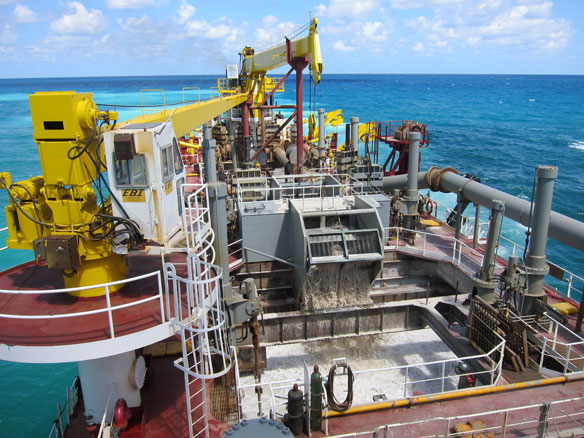Onboard a sand dredger. Photo source: © Denis Delestrac.
“Beach nourishment projects like this have become commonplace along the US East and Gulf Coasts. These projects have immediate environmental impacts through burial of nearshore habitat and increased turbidity during project placement.The cumulative environmental impacts of doing this repeatedly on the same beach while conducting projects from Maine to Texas is unknown. But, we should be concerned. ” —Robert S. Young, PhD, Director, Program for the Study of Developed Shorelines, Professor, Coastal Geology, Western Carolina University
Excerpts;
To push back against erosion caused by sea level rise and storms, four beachfront strips on Miami Beach are receiving a federally funded face lift. That means dumping fresh sand on the beach — $16 million…
Crews will dump 100 truckloads of sand every day. A total of 61,000 tons will be used…
Also of Interest:
In South Florida’s war against the tides, it may be time to recognize that discretion is the better part of valor. For the past 70 years, the state of Florida has spent more than $1.3 billion on packing sand onto eroding beaches…
Column: High-rises spell the end for Florida beaches; By Orrin H. Pilkey and J. Andrew G. Cooper; Tampa Bay (07-25-2017)
Floridians are becoming more attuned to sea level rise and more familiar with nuisance flooding related to the rising sea. However, we believe there is less recognition that by century’s end it is likely that most of Florida’s major beaches will be permanently gone…
Sand washes away as quickly as it can be dumped, Bathtub Beach, FL, TCPalm News (11-17-2017)
Between 2004 and 2014, some $13.6 million was spent on beach renourishment in Martin County, Florida. About $7.1 million came from local funds — your tax dollars. In the past two years, more than $6 million from a variety of sources has been spent to renourish and restore dunes at Bathtub Beach alone…
A swath of Miami Beach was washing away. The fix? Dump 285,000 tons of sand on it; Miami Herald (03-28-2017)
To widen a 3,000-foot stretch of Miami Beach’s shore that was washing away, the U.S. Army Corps of Engineers dumped 285,412 tons of sand on Mid-Beach, a $11.5 million project, funded with a combination of federal, state and county dollars….
Factbox: Sifting Through U.S. Beach Sand Numbers; Reuters (02-16-2018)
A look at the billions of dollars behind beach renourishment: Is it worth it?; WMBF (10-15-2018)
“A Never-Ending Commitment”: The High Cost of Preserving Vulnerable Beaches; ProPublica (09-27-2018)
The U.S. government pays to dump truckloads of sand onto eroding beaches, in a cycle that is said to harm ecosystems and disproportionately benefit the rich…
Beach rebuilding efforts won’t stave off climate change impacts forever; Guardian UK (09-20-2018)
Can Adding Sand to Beaches Save Them? How Stuff Works (04-13-2018)
The question is, can beach nourishment keep up with the ever-increasing forces of climate change or, like Sisyphus forever pushing his boulder up the hill, is adding sand to beaches an expensive, temporary fix to a long-term problem?..
Coastal geologist criticizes beach renourishment efforts; By Robert S. Young, PhD; The State (08-17-2016)
Rob Young, who heads the Program for the Study of Developed Shorelines at Western Carolina University, said the government is subsidizing coastal development with renourishment money – and that’s costing taxpayers. Communities across the country have spent millions of dollars renourishing beaches. Those efforts encourage people to rebuild after every major hurricane…
Sand re-nourishment could be culprit for beach-related accidents; CBS Miami (11-13-2019)
A group of researchers found that after beach re-nourishment projects, there was a significant increase in the number of drownings and serious accidents along those same beaches…
Widening beaches might bring more hazards, researchers say; Sun Sentinel (04-04-2018)
Widening beaches might be linked to an increase in accidents, according to new data. The number of ocean rescues spikes after beaches are buffed up, according to the data published in the Journal of Ocean Research…
Sand, Rarer Than One Thinks: A UNEP report (GEA-March 2014)
Despite the colossal quantities of sand and gravel being used, our increasing dependence on them and the significant impact that their extraction has on the environment, this issue has been mostly ignored by policy makers and remains largely unknown by the general public.
In March 2014 The United Nations released its first Report about sand mining. “Sand Wars” film documentary by Denis Delestrac – first broadcasted on the european Arte Channel, May 28th, 2013, where it became the highest rated documentary for 2013 – expressly inspired the United Nations Environment Programme (UNEP) to publish this 2014-Global Environmental Alert.









